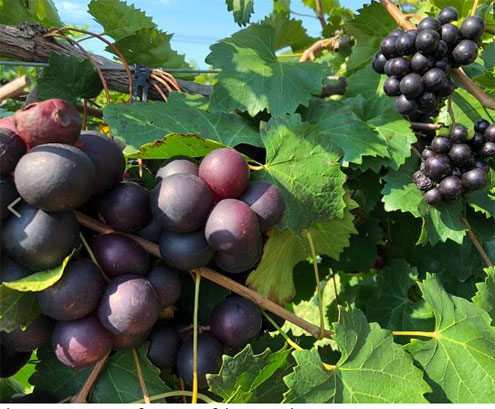Texas A&M AgriLife to provide expertise, field trial locations for $7 million effort to benefit grape growers
Texas A&M AgriLife will collaborate in a first-of-its-kind project to propagate new seedless muscadine grape varieties to benefit grape growers in Texas and beyond.
The four-year, $7 million project, “Through the Grapevine: Developing Vitis x MuscadiniaWide Hybrids for Enhanced Disease Resistance and Quality,” is funded by a U.S. Department of Agriculture National Institute Food and Agriculture grant.
The research involves the Texas A&M College of Agriculture and Life Sciences, the University of Arkansas, the University of Georgia and several other institutions and agencies. Research and extension efforts related to the project will be conducted and implemented with industry partners and stakeholders.

“This project is a part of a larger departmental mission focused on sustainability, wellness and food security,” said Amit Dhingra, Ph.D., head of Texas A&M’s Department of Horticultural Sciences. “The proposed work represents an opportunity to identify new muscadine varieties for Texas to support fresh market sales, wine and other products.”
Improving the muscadine grape
Muscadine grapes are one of the 13 species of grapes native to Texas and the only native grape species that has been improved through breeding and selection. After over 100 years of muscadine breeding, plant breeders developed the first seedless selections.
Muscadines grow well in East Texas due to the area’s humid climate but are also successful in a variety of soil types, especially those that are pH neutral or slightly acidic. In addition to pest and disease tolerance, the grapes demonstrate good drought tolerance.
The grapes are typically large and ripen individually. While the skin is somewhat tough, the fruit is highly flavorful and popular for use in jams, jellies and juices as well as home and commercial winemaking.
Developing varieties for both fresh and wine markets
The overall project will involve more than 30 viticulturists, grape breeders, physiologists, food scientists and economists. Their efforts will support grape growers in propagating new seedless muscadine selections for trials across the southeastern U.S.
Texas A&M AgriLife team members from the Department of Horticultural Sciences participating in the project include Justin Scheiner, Ph.D., Texas A&M AgriLife Extension Service viticulture specialist and associate professor, Bryan-College Station; Michael Cook, AgriLife Extension program specialist and doctoral student, Denton; and Andrew King, Ph.D., Texas A&M AgriLife Research ornamental horticulture scientist and assistant professor, Overton. Scheiner will provide leadership for the Texas A&M AgriLife team.
Texas A&M AgriLife will also host two research vineyard sites in northeastern and southeastern Texas to evaluate new “fresh eating” or table selections as well as those for processing. One research trial will be planted at Thomas Ranch near Richards, which is operated by AgriLife Research. The other trial will be at the Texas A&M AgriLife Research and Extension Center at Overton. Muscadine grape trials in Texas will be planted in the spring of 2025.
Another team member, Stephen Talcott, Ph.D., professor of food chemistry in the Texas A&M Department of Food Science and Technology, will analyze fruit composition and post-harvest quality of all materials from these trials.
“This project will seek to crossbreed muscadines and Vitis vinifera, or common, grapes to get the best characteristics of these two grape species,” Scheiner said. “Both generations of grapes will be instrumental in breeding new high-quality, climate-resilient cultivars for both the fresh market and wine production.”
Cook said he and the others are thrilled to be part of a national multi-disciplinary team exploring ways to improve muscadines, as well as bunch grapes, to provide tangible solutions for growers.
“We are particularly excited in the first objective of the project where we are doing trials of advanced muscadine cultivars,” he said. “This effort could change the face of the grape industry in Texas.”
According to Cook, various environmental and input factors have made growing grapes more difficult, risky and costly over time, so the results of this multi-objective study will be vital in aiding growers in regard to future cultivar selection and best practices tailored to a changing viticulture landscape.
“Texas grape growers have expressed great interest in this project and will be kept up to date with results and recommendations through various AgriLife Extension programming in the coming years,” Dhingra added.

